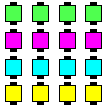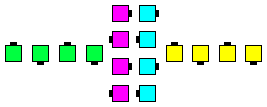Quadruple formations consist of four adjacent
formation some of which may have positions occupied by phantoms.
The given formation is usually a 4-dancer formation such as a Box,
Column, Diamond, Line, or Wave. Work with the dancers and phantoms within your
formation. Keep track of the phantoms and allow spaces for them
upon completion of the call. When formation is a 4-dancer formation,
there should be a total of 16 dancer | phantom positions before and after each call.

| | Quadruple Box |

| |

| | Quadruple Line | | Quadruple Column |
|
Kommentarer:
-
Quadruple formation is analogous to
Triple formation
except that there are 4 occurrences of the given formations instead of 3.
-
When doing a call in Quadruple formation, work only
with the dancers and phantoms within your formation. Shape-changing
calls are allowed and will end in a different set of Quadruple formations.
-
Quadruple formation is clearer for dancers than
Split Phantom formation,
as dancers only need to track their 4 spots, rather than the 8 spots for Split Phantom.
-
Typically, a long axis traverses through the entire set of 4 formations.
Visualize surrounding each formation within an imaginary bubble.
The long axis is the line that traverses the 4 formations, connecting the four bubbles in
a linear fashion. Dancers work within their bubble to do the given call,
which may be a shape changer.
Upon completion of the call, the new formation (including any phantoms) is still enclosed in a
bubble shaped to enclose the new formation, and the bubbles must still be connected in
a linear fashion. Stay within your formation and adjust the four bubbles
as necessary to line up side-by-side along the original long axis.
-
Assume that phantoms are facing in whatever direction is needed to do
the given call. For Quadruple Wave, phantoms must be facing such
that each formation is a Wave. The caller can optionally be more specific and give
the exact name of the formation (e.g., Quadruple R-H Two-Faced Line).

| (End-to-End) Quadruple Column|Line|Wave (Infrequently used) |

| | Quadruple Diamond |
|
|
|
|
|
|
|
|
Note: Quadruple Wave Turn The Key is not the same as Split Phantom Waves Turn The Key. In the former case, dancers work within their Wave of 4, and the Counter Rotate 1/4 is a Lockit;
whereas in the latter case, the Counter Rotate 1/4 is an 8-dancer (Parallel Lines) movement. |
Sometimes, the outside formations can be at a 90° angle to the inside
formations. For example,

| | Quadruple Wave |
|
The formation may occasionally be a non-4-dancer formation. For example,

| | Quadruple Wave of 3 |
|
Also possible, but rarely seen, are 6- or 8-dancer Quadruple formations
(e.g., Quadruple Tall Six, Quadruple Hourglass, etc.).